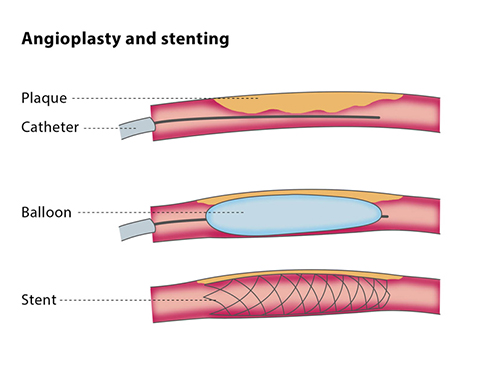Angioplasty is a medical procedure used to treat narrowing of the arteries that supply blood to the heart. This is accomplished by inflating a small balloon inside the artery to increase the blood flow to the heart. It may be performed on an emergency basis following a heart attack or on an elective basis when conservative treatment measures have failed to relieve symptoms of Coronary Artery Disease such as chest pain and shortness of breath.
Balloon Angioplasty is a procedure used to treat narrowing of the coronary arteries that supply blood to the heart. This involves inflating a small balloon inside the artery so as to increase the blood flow to the heart. It may be performed as an emergency procedure after a heart attack or to treat symptoms of Coronary Artery Disease (CAD) such as chest pain and shortness of breath.
Stenting is a procedure of inserting a metal stent that helps in the restoration of blood flow when there is any blockage in the arteries. Stent is an artificial device, a mesh-like tube made up of stainless-steel that has the ability to expand inside the blocked artery. Stents are mounted on narrow tube (catheter) which has a deflated balloon towards the end. Small incisions are made either on the upper thigh, neck, or arm. Through one of the incisions, the catheter along with the deflated balloon is inserted in to the blocked artery. In the artery, the balloon swells up allowing the stent to lock and expand. Later the balloon is deflated and removed. The stent remains permanently in the artery where the inner lining of the artery will start to grow over this stent. Stent will always keep the artery open and prevents the closure of the artery.
Stents are used in some of the heart conditions such as coronary heart disease (CHD). The arteries that carry blood from heart to different parts of body are blocked by fatty substances, plaques, restricting the blood flow to the heart. During angioplasty, the stents are placed in the coronary artery that will widen the passage of blood vessels and improves the blood supply.

Blood clot is commonly observed in patients who have undergone coronary stenting. These blood clots reduce the oxygen flow to the blood. This complication is mild and occurs only during the first few days of your surgery. Blood thinning agents such as aspirin and clopidogrel are prescribed in patients who have undergone stent procedure to prevent formation of blood clots in the stent.
Peripheral arterial angioplasty and stenting is a surgical procedure employed to widen the narrowed arteries in patients with peripheral arterial disease. Peripheral arterial disease is a condition characterised by the narrowing of the peripheral arteries supplying blood to the neck, arms, legs, lower abdomen, and kidneys. Peripheral arterial disease is often caused by accumulation of fatty deposits (plaques) in the arterial walls, reducing blood flow through them.
Peripheral angioplasty with stenting is a minimally invasive procedure performed to improve blood flow through the blocked peripheral arteries. The procedure is often performed in the cardiac catheterization laboratory with the patient under local anaesthesia.